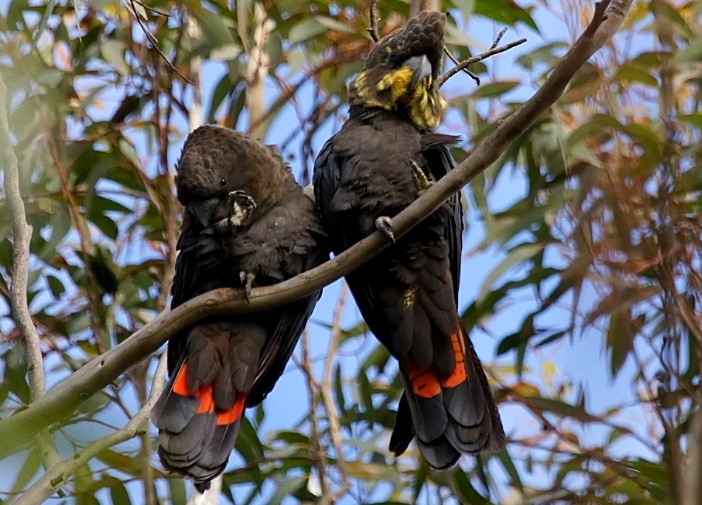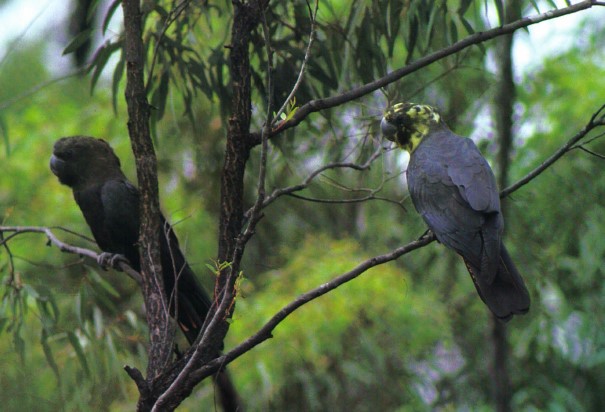Family: The glossy black cockatoo is the smallest member of the subfamily Calyptorhynchinae.
Behavior & Habitats: A Glossy Black-Cockatoo is a small, unobtrusive bird found in the eucalypt forests of eastern Australia. These black cockatoos do not gather in large flocks nor do they fly over trees noisily. In groups of twos and threes, rarely larger than ten, they feed quietly during the day in low-shaded casuarina trees. It usually feeds on the seeds of the she-oak that grows in open forests and woodlands. A she-oak tree is an evergreen native tree with long, needle-like leaves. It is usually possible to distinguish males and females based on their appearance.
Sound: The only sound they make for hours on end is a soft clik-clik-clik as their bills break into casuarina cones. There is a soft, drawn-out wheezing call, tarr-red, given in contact, by Glossy Black-Cockatoos. Moreover, alarm call of guttural notes. In comparison with other black cockatoos, it is much quieter and less raucous.
Read More – The Spectacular Palm Cockatoo
Diet: The birds feed exclusively on casuarina seeds, which they win from cones in an unusual way. Firstly, they transfer the cone from the left foot to the lower mandible by biting off a cone from a branchlet. It is remarkable how the lower mandible of the Glossy Black-Cockatoo is broadened and hollowed at the tip.
While the tongue rotates the cone and the upper mandible bites in to break off seed-bearing chunks, instead of cutting it, the tip supports it firmly. When the chunks build up on the inside of the upper mandible, the bird discards the cone and uses the tongue and right point of the lower mandible to husk out the seeds. In the end, the birds return to cone-chewing once the chaff has fallen to the ground and leaves telltale signs.
It is only through their large bile that cockatoos can handle cones of species such as C. littoralis and C. stricta. As long as enough fruit is ripening each year, they remain nearby all year long, and move on whenever it does not. The glossy black cockatoo eats seeds from eucalyptus, angophora, acacia, and hakea, and larvae from insects. Their diet also includes cypress pine seeds in Central West New South Wales.
Nest: The black-cockatoo nests in tree cavities, but how it selects the hollow and prepares it for nesting is unclear. March-August is the nesting and breeding month. A nest is usually a large tree hollow lined with decayed wood, usually in a dead tree, with an entrance high up in the tree. An entrance of 20–25 cm in width and a height of 10–20 meters are typical characteristics of nesting hollows found in old, large eucalypt trees (living or dead).
Breeding: The incubation of the single egg is carried out by the female. The male feeds her all the time during this period while she sits and watches. She broods the nestling continuously for the first week or so after it hatches, but thereafter only at night. Each parent feeds the chick in the morning and at night.
Similar Species: Glossy Black-Cockatoos are frequently confused with Redtaileds, but they can be distinguished by their soft, drawn-out calls and lack of crests. In addition, the female has a blackish bill and yellow patches on her head and neck.
Alternative names: This bird is also known as the Casuarina Cockatoo, and Leach’s Black-Cockatoo.
Size: The size of the Glossy Black-Cockatoo is about 470-500 mm in length, with a long rounded tail about a half body length.
Read More – Are Dracula Parrots Real?

Identification:
MALE: Their sexual characteristics are dimorphic. Dusky brown body plumage with brown-black undertail coverts. With the exception of two central feathers, the tail has a broad band of bright red through the center. A naked Gere. Dark brown is the color of the eyes, and dark grey is the color of the skin surrounding the eyes. The bill is dark grey. Feet and toes are dusky grey and small.
FEMALE: With yellow patches on the head and sides of the neck; the tail band is red with varying amounts of yellow washed through it, and is barred black. As with males, the bill is dark grey.
IMMATURES: It has sparse yellow spotting on the wings and belly of young females, similar to that of adult females. The tail of a young male is red-barred black.
DOWNY YOUNG: Densely, long, yellow-downed.
Eggs: One white egg is laid by the bird, which measures 45 x 33 mm and has an oblong-oval shape. There is about a 29-day incubation period, which is carried out by a female. Young fledge in about nine-ten weeks.
Distribution: Throughout eastern Australia, from Mackay north to Cocoparra and Strathbogie Ranges, where casuarinas are common, it can be found in coastal forests and open inland woodlands. An isolated population of fewer than 100 individuals exists on Kangaroo Island, South Australia.
Races: No races.
Read More – Painted Honeyeater Call
